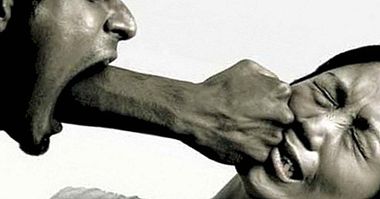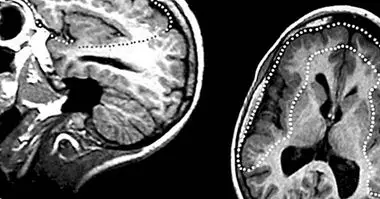Depressive personality: causes, symptoms and risk factors
Surely you have ever thought that in life there are people who always tend to see things in a particularly negative way. They breathe pessimism, sadness, dejection and fatalism, and it seems almost impossible to get them to see things a little less black.
They see the future in such a negative way that they can even spread their pessimism and despair . And it seems that little importance have the positive things that happen to them in life, they always see something negative in it, as if they were wearing glasses with an exclusive filter to perceive clouds and sadness.
What happens with this type of people? Do they suffer from a major depression constantly? Do you have a persistent depressive disorder? Is being depressed a personality trait?
In this article we are going to talk about depressive personality disorder (PDD), which does not appear in the current classifications such as the DSM-5 or the ICD-10, but has been studied over many years by such well-known authors as Kraepelin (1896), Schneider (1923), Millon (1994) and Beck (1979).
Depressive personality disorder according to Theodore Millon
According to Theodore Millon, depressive personality disorders (what Millon calls the "pattern of surrender") are encompassed within Personalities with difficulties for pleasure. According to Millon, depressed people have a series of personality traits in common, which can be manifested and described at different levels:
1. Behavioral level
Expressively dejected, the appearance and the state transmit irremediable helplessness . Interpersonally defenseless: due to the feeling of vulnerability and lack of protection, he will beg others to take care of him and protect him, fearing abandonment. Will seek or demand guarantees of affection, perseverance and dedication. They tend to be introverted, so they may have trouble finding a partner. When they find, they become very dependent on it.
2. Phenomenological level
They are cognitively pessimistic: they show defeatist, fatalistic and negative attitudes in almost everything. They always expect the worst. Interpret the facts of life in the most devastating way possible, and feel desperate because things will never improve in the future.
His self-image is "useless". They judge themselves as insignificant, useless, incapable, worthless neither for themselves nor for others . They feel guilty for not having positive traits. Object representations abandoned: the early experiences of life are lived empty, without wealth, without happy elements.
3. Intrapsychic level
Ascetic mechanism : believes that he should do penance and deprive himself of the pleasures of life. He rejects enjoyment, and he also criticizes himself a lot, which can lead him to self-destructive acts.
Decreased organization : impoverished coping methods.
4. Biophysical level
Melancholy mood: easy, sad, sad, angry, worried and tending to ruminate ideas. They tend to feel peevish. They get angry with those who pretend to exaggerate the good at the expense of the realistic.
Clinical characteristics according to the DSM-IV-TR (APA, 2000):
In 1994, the APA introduces the term "Personality Depressive Disorder" in the Appendix of Research Criteria for Personality Disorders in the DSM-IV. According to the DSM-IV-TR (APA, 2000) the fundamental characteristics of depressive personality disorder (PDD) consist of:
- A rooted pattern of depressive behaviors and cognitions.
- They see the future negatively, they doubt that things will improve and anticipate the worst. They show defeatist and fatalistic attitudes.
- They are very serious, lack a sense of humor, are not allowed to enjoy or relax in their day to day.
- As for your physical appearance, it often reflects your depressed mood. Sunken posture, psychomotor retardation and depressed facial expression are usually visible.
- They look sad, discouraged, disappointed and unhappy.
- Their self-concept focuses on beliefs of futility and inadequacy, and they have low self-esteem.
- They are self-critical, they are often belittled.
- Tend to rumination and constant worries.
- They are pessimistic.
- They feel helpless and helpless.
- They criticize and judge others negatively.
- They tend to feel guilt and remorse.
- Passive, with little initiative and spontaneity.
- They require the love and support of others.
- The symptoms do not appear exclusively during the course of major depressive episodes and are not better explained by the presence of a dysthymic disorder.
Differential diagnosis
People with a depressive personality are at great risk for major depressive disorder or persistent depressive disorder (formerly known as "dysthymia").It is necessary to clarify that the persistent depressive disorder is transient, it can be provoked by a stressful stimulus and appear at any moment, while the major depressive disorder is permanently linked to the personality and interferes in most areas of the subject's life over time. In other words, the symptom picture is permanent and causes clinically significant discomfort or social or occupational deterioration.
A large part of the controversies in relation to identifying depressive personality disorder as a separate category is the lack of utility to differentiate it from dysthymia. Further, it has been suggested that personality depressive disorder can be confused and overlap with other personality disorders (dependent, obsessive compulsive and avoidance).
Causes
What are the causes of depressive personality disorder? We will emphasize the environmental factors that seem to be related to this disorder, since the biological influences are not entirely clear (Millon and Davis, 1998):
1. Emotional attachment in the deficit childhood
If the child does not experience unequivocal signs of acceptance and affection during childhood, feelings of emotional detachment, insecurity and isolation may form. . These children lack experiences of affection and proximity to their parents, who are often distant and indifferent. Children tend to surrender to the search for parental emotional support, learn to make little demands on their environment and develop feelings of helplessness and hopelessness.
2. Helplessness
The child who in the future will be a depressed adult, is humiliated in childhood by his father, who will usually make him feel useless , preventing them from developing feelings of competence and confidence. Children learn that they do not know how to function well on their own, and they begin to believe that they will never have that capacity, that is why they feel profoundly hopeless.
3. Reinforcement of sadness as an identity
The expressions of sadness and helplessness help them to attract attention, so they get others to give them affection and displays of affection they need so much . In this way, they get reinforcements for their depressive behavior. This can be a double-edged sword, because in spite of the fact that in the short term it can work, in the long term what is achieved is that its environment gets tired of its depressive behavior and ends up avoiding it.
4. Disparity between what is and what should have been
Feeling constantly unloved, useless and inadequate, the person with personality depressive disorder finds differences between what supposedly should have been and what it really is. Many times this disparity is born from the unrealistic expectations placed on the part of the parents in the child. From this disparity are born feelings of emptiness and despair.



















